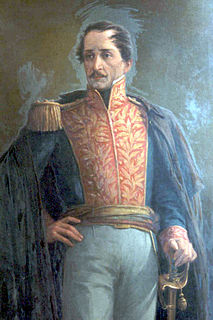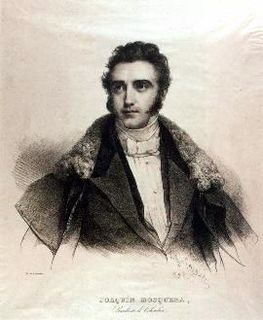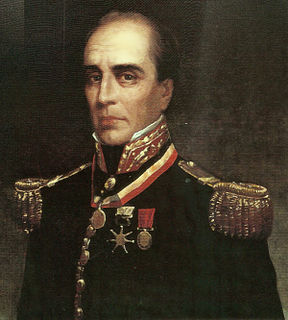
Rafael Wenceslao Núñez Moledo was a Colombian author, lawyer, journalist and politician, who was elected president of Colombia in 1880 and in 1884.
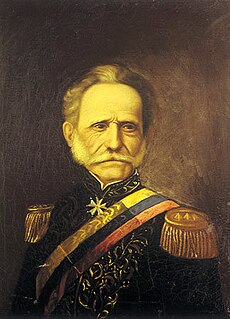
Tomás Cipriano Ignacio María de Mosquera-Figueroa y Arboleda-Salazar was a Colombian general and political figure. He was president of Colombia four times. The first time was as president of Republic of New Granada from 1845 to 1849. During the Colombian Civil War of 1860–1862 he led liberal forces in a civil war against conservative factions. After the liberals won, a new, federalist constitution was implemented, which established a two-year presidency, and the nation renamed the United States of Colombia. Mosquera served twice as president of the new government. From 1861 to 1862 he served in a non-elected, interim manner, while the constitution was written. From 1862 to 1864 he served in an elected manner. He had a fourth term from 1866 to 1867. Due to the liberal reforms carried out under his leadership, he is considered one of the most important persons in Colombian history of the 19th century.

Elections in Angola take place within the framework of a multi-party democracy and a presidential system. The National Assembly is directly elected by voters, whilst the leader of the largest party or coalition in the National Assembly automatically becomes President. The country is currently a one-party dominant state, with the MPLA as the dominant party.
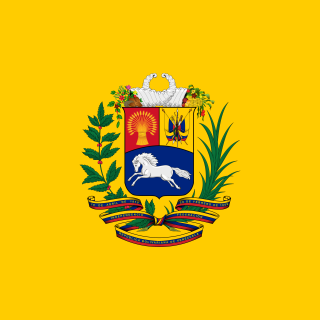
The President of Venezuela, officially known as the President of the Bolivarian Republic of Venezuela is the head of state and head of government in Venezuela. The president leads the National Executive of the Venezuelan government and is the commander-in-chief of the National Bolivarian Armed Forces. Presidential terms were set at six years with the adoption of the 1999 Constitution of Venezuela, and presidential term limits were removed in 2009.

Colombian Conservatism is a broad system of conservative political beliefs in Colombia that is characterized by protectionism, support for Catholic values, social stability and anti-totalitarianism. Its history began with the creation of political parties that represent conservatism in Colombia. One characteristics of Colombian Conservatism, in contrast to many other geographic subsets of conservatism, is its strong emphasis in protectionism, which is considered by many Colombian conservatives to be necessary to create a fair market.

José Hilario López Valdés was a Colombian politician and military officer. He was the President of Colombia between 1849 and 1853.
The War of the Supremes was a civil conflict in Republic of the New Granada from 1839 to 1841 caused by the ambitions of various regional leaders (gamonales) to seize power and depose President José Ignacio de Márquez. It was called the War of the Supremos because of the participation of General José María Obando and other revolutionary gamonales who called themselves jefes supremos.
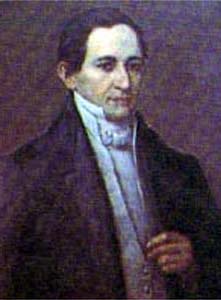
Domingo de Caycedo y Sanz de Santamaría was a Colombian statesman who served as Vice-president of Gran Colombia and the Republic of New Granada, and due to the absence of the presidents, he himself served as President a total of eleven times, making him the person to have served more times as President of Colombia. He is also credited for creating the Republic of New Granada after the division of Venezuela and Ecuador.

Pedro Alcántara Herrán Martínez de Zaldúa ) was a Colombian general and statesman who served as President of the Republic of the New Granada between 1841 and 1845. As a general he served in the wars of independence of the New Granada and of Peru.

The constitutional history of Colombia is the process of formation and evolution of the different constitutions that Colombia has had since its formation.

Roberto Urdaneta Arbeláez is a Colombian Conservative party politician and lawyer who served as President of Colombia from November 1951 until June 1953, while President Laureano Gómez was absent due to health issues.
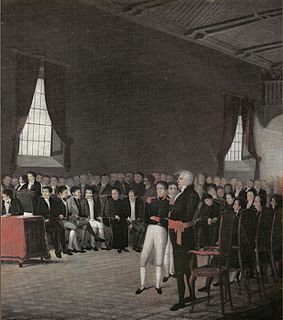
The history of Venezuela reflects events in areas of the Americas colonized by Spain starting 1522; amid resistance from indigenous peoples, led by Native caciques, such as Guaicaipuro and Tamanaco. However, in the Andean region of western Venezuela, complex Andean civilization of the Timoto-Cuica people flourished before European contact. In 1811, it became one of the first Spanish-American colonies to declare independence, which was not securely established until 1821, when Venezuela was a department of the federal republic of Gran Colombia. It gained full independence as a separate country in 1830. During the 19th century, Venezuela suffered political turmoil and autocracy, remaining dominated by regional caudillos until the mid-20th century. Since 1958, the country has had a series of democratic governments. Economic shocks in the 1980s and 1990s led to several political crises, including the deadly Caracazo riots of 1989, two attempted coups in 1992, and the impeachment of President Carlos Andrés Pérez for embezzlement of public funds in 1993. A collapse in confidence in the existing parties saw the 1998 election of former coup-involved career officer Hugo Chávez and the launch of the Bolivarian Revolution, beginning with a 1999 Constituent Assembly to write a new Constitution of Venezuela. This new constitution officially changed the name of the country to República Bolivariana de Venezuela.
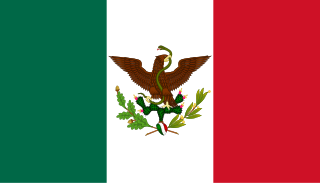
The Second Federal Republic of Mexico is the name given to the second attempt to achieve a federalist government in Mexico. Officially called the United Mexican States, a federal republic was implemented again on August 22, 1846 when interim president José Mariano Salas issued a decree restoring the 1824 constitution. Like the Mexican Empire, the First Federal Republic and the Centralist Republic it was a chaotic period, marked by political instability that resulted in several internal conflicts. Mexico's loss of the war with the United States saw half the territory Mexico claimed become part of the United States. Even though Antonio López de Santa Anna played a major role in much of this history, he returned to the presidency yet again, selling northern territory coveted by the United States contiguous to territory it just gained in the Treaty of Guadalupe Hidalgo. The sale of the Mesilla Valley was for many the final straw, and liberals promulgated of the Plan of Ayutla, calling for the overthrow of Santa Anna. Santa Anna went into exile and the liberals set about implementing their vision of Mexico.

Indirect presidential elections were held in Gran Colombia on 4 May 1830 following the resignation of incumbent President Simón Bolívar. Joaquín Mosquera was elected President, whilst Domingo Caycedo was elected Vice President.


